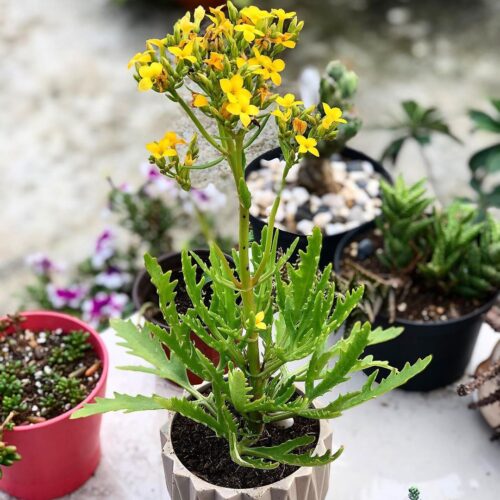Kalanchoe laciniata (Christmas Tree Plant) grows in scrubs, open bushland, and thicket borders. It is easy to plant and care for.
Also known as Cathedral Bells, Fir Tree Kalanchoe, Lace leaf Kalanchoe, and Christmas tree plant, this species belongs to Morocco, southwestern Africa, eastern, southern, and Southern India. This succulent produces an erect, red stem and thick, fleshy, three-lobed, green foliage in diverse shapes; the leaflets have serrated edges. It can grow up to 5 feet tall. Kalanchoe laciniata offers clusters of scented yellow-green to orange blooms in summer, making inflorescence like a panicle.
Fact: This plant is photoperiodic.
USDA Zones: 10a-11b
Propagating Kalanchoe laciniata
You can propagate kalanchoe in spring or summer. Choose a 2-3 inches long stem cutting with two sets of leaves and no flowers. Make a cut above the leaf node and allow it to be callous for a few days. After that, fill a pot with a cactus or succulent mix and plant the cutting in it. Cover the container with a plastic bag and punch some holes in it for air circulation. Keep the soil moist but not soggy. Place the plant in bright, indirect light; the temperature has to be above 50 F.
Once the cuttings establish roots and you see stem or leaf growth, start caring for the plant like a full-grown plant.
Ideal Growing Conditions for Kalanchoe laciniata

Light
Your new kalanchoe needs bright but not direct sunlight. If it doesn’t get enough light, the plant will stretch and grow unevenly toward the sun, which gives it a lopsided look.
Soil
Use well-draining, light soil; you can also use succulent or cacti mix.
Water
Water the plant moderately in spring and fall when it’s growing the most. During the hot summer, when the plant is resting, and in winter, when growth slows down, water less frequently. Let the top of the soil dry before watering again. Keep an eye on the thick leaves for signs of water stress.
Temperature
Do not allow the temperature to go down below 55 F (13 C)
Kalanchoe laciniata Care
Fertilizer
Apply a balanced liquid fertilizer bi-weekly in the growing season or use slow-release pellets. Follow the instructions on the label for dosage.
Repotting
Repot this small plant every few years. Be careful when handling them, as the leaves are fragile and can break easily. Clay pots are a good choice for Kalanchoes, but make sure the pots have good drainage, and the saucers can be emptied easily.
After repotting, water the plant well to settle the soil and remove air pockets. Keep the plant slightly dry to encourage growth and continuous blooming.
